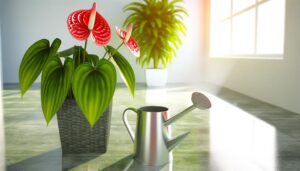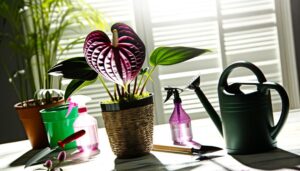Caring for Your Pink Anthurium Houseplant – A Step-by-Step Guide
Caring for your pink anthurium houseplant involves following specific horticultural practices. Position the plant in indirect, bright light, ideally near an east or north-facing window, with light intensity maintained between 10,000 to 20,000 lux.
Maintain consistent soil moisture, watering when the top inch of soil is dry using room-temperature, filtered water. Utilize a well-draining potting mix enriched with organic matter and guarantee humidity levels are between 60% to 80% using a humidifier if needed.
Fertilize bi-monthly during the growing season with a balanced, water-soluble fertilizer diluted to half strength. To explore each aspect in greater detail, further guidance follows.

Key Takeaways
- Ensure bright, indirect light and avoid direct sunlight to prevent leaf scorching.
- Water when the top inch of soil is dry, using room-temperature, filtered water.
- Use a well-draining potting mix with orchid bark, peat moss, perlite, and activated charcoal.
- Maintain humidity levels between 60% and 80% using a humidifier or water tray.
- Fertilize bi-monthly with a diluted, balanced, water-soluble fertilizer (20-20-20 N-P-K) during the growing season.
Light Requirements
To maximize the growth and health of your pink Anthurium houseplant, it is essential to provide indirect, bright light. Direct sunlight can cause leaf scorching and hinder photosynthesis. Position the plant near an east or north-facing window where it can receive diffused sunlight. Alternatively, employ sheer curtains to filter intense light from south or west-facing windows.
Light intensity should ideally range between 10,000 to 20,000 lux. Using a light meter can ensure precise measurement. Inadequate light levels may lead to etiolation, characterized by elongated stems and pale leaves. Conversely, excessive light can cause chlorosis and necrosis in leaf tissues.
Maintaining optimal light conditions will promote robust foliage, vibrant spathes, and overall physiological health of the Anthurium.
Watering Schedule
Ensuring an ideal watering schedule for your pink Anthurium involves maintaining consistent soil moisture without allowing the substrate to become waterlogged. Overwatering can lead to root rot, while underwatering may cause dehydration stress. Water the Anthurium when the top inch of soil feels dry to the touch. Employ room-temperature, filtered water to avoid chlorine and fluoride damage. During winter, reduce watering frequency as the plant's metabolic rate slows down.
| Season | Frequency |
|---|---|
| Spring | Every 5-7 days |
| Summer | Every 3-5 days |
| Fall | Every 7-10 days |
| Winter | Every 10-14 days |
Regularly monitor humidity levels, as Anthuriums thrive in high humidity environments, ideally between 60-80%. Employ a hygrometer for precise readings.
Soil and Potting
Selecting a well-draining potting mix enriched with organic matter is crucial for the optimal growth of your pink Anthurium.
The perfect substrate should consist of a mix of orchid bark, peat moss, and perlite, maximizing aeration and moisture retention. A common ratio might include 40% orchid bark, 30% peat moss, and 30% perlite. This composition guarantees sufficient root ventilation and prevents waterlogging, which can result in root rot.
Additionally, incorporating activated charcoal can assist in maintaining soil freshness and pH balance. When potting, choose a container with ample drainage holes to facilitate proper water outflow. Ensure the pot size is suitable; a pot that is too large may retain excess moisture, while a too-small pot can restrict root development.
Humidity Needs
Maintaining a humidity level between 60% and 80% is crucial for the thriving growth of pink Anthurium houseplants. Optimal humidity ensures proper transpiration and nutrient uptake, thereby enhancing overall plant health. To achieve these levels, consider using a humidifier or placing a water tray near the plant. Consistent ambient moisture can prevent leaf browning and tip curling, common signs of low humidity stress. Regularly monitor humidity using a hygrometer for precision.
| Method | Description |
|---|---|
| Humidifier | Automated device to maintain desired humidity levels |
| Water Tray | Placing a water-filled tray near the plant to increase local humidity |
| Misting | Spraying water on leaves to temporarily boost humidity |
| Grouping Plants | Clustering plants together to create a micro-humid environment |
| Pebble Tray | A tray filled with pebbles and water placed under the plant pot |
Ensuring these conditions will create an ideal microclimate for your pink Anthurium.
Fertilization Tips
Proper moisture levels are crucial, but equally important is providing your pink Anthurium with an appropriate fertilization regimen to support its lush foliage and vibrant blooms.
Utilize a balanced, water-soluble fertilizer with a ratio of 20-20-20 (N-P-K) to ensure a thorough nutrient profile. Administer the fertilizer bi-monthly during the growing season (spring and summer) by diluting it to half the recommended strength to prevent root burn and nutrient toxicity.
Cease fertilization during the dormant period (fall and winter) to allow the plant to rest. Monitor for signs of over-fertilization such as yellowing leaves or salt buildup on the soil surface.
Regular leaching of the soil can help prevent nutrient imbalances and maintain ideal plant health.
Conclusion
To wrap up, the meticulous care of the pink anthurium houseplant necessitates an elaborate symphony of precise light exposure, regimented hydration, specific soil composition, controlled humidity, and calculated fertilization.
One might jest that the plant demands more attention than an aristocrat's wardrobe, yet the rewards of an exuberantly thriving anthurium are worth the comedic endeavor.
As a result, the scientific precision required may elevate one's horticultural prowess to that of a botanical virtuoso.






